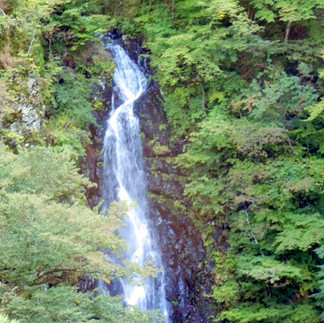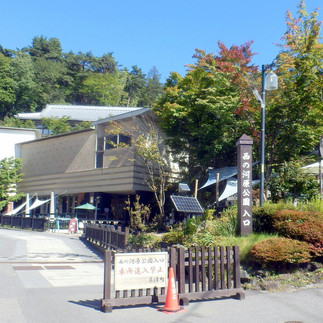My husband and I went to hot springs in Kusatsu and Manza as well as to
see colored leaves on Sept. 29 and came back home on Oct.1, 2022. He drove all the way.
Kusatsu continues to fascinate us with its countless hot springs, snow sports, and other outdoor adventures.
Before getting to Kusatsu, we stopped at Yamba Dam and strolled around for a while.
You'll see 'Fudo waterfall' and a red pine with some azalea (mitsuba-tsutsuji) growing on the branch, which they say symbolizes living in harmony with each other.
Kusatsu hot springs boast of large volumes of sulfur-rich hot water. The picture on the left shows a close shot of the wooden conduits in the Yubatake (Hot Water Field) which is one of the sources of hot spring water and which is located in the center of Kusatsu. Since the hot spring water at a temperature of more than 70 degrees Celsius bubble up to the surface, it is necessary to cool down the hot water by running through the conduits. Then it is distributed to the various ryokan and public baths. And on top of that, yunohana, or sulfuric sediment, collected in the wooden conduits is sold as "bath salt" at the shops.
It's a ten minutes walk from Yubatake to Sainokawara Park located in the valley. When you walk trails around the park, you'll see hot spring water bubbling to the surface all around, where you can relax and soak your feet in the hot spring water free. At the end of the trails is Sainokawara Rotenburo, a public bath with gender-separated outdoor hot spring pools with admission 700 yen.
We saw rowanberries (ナナカマド) already having turned red on the way to Mt. Kusatsu-Shirane (2165m, or 7103ft) which has three crater lakes on the summit. The largest is 'Yugama' which is an acidic emerald green lake, 300m in diameter and 30m depth. The photo on the right is 'Yugama' which was taken 13 years ago when it was not banned to climb the path up to Yugama.
This is a map of Mt. Shirane and Mt. Moto-shirane. Mt. Moto-shirane unexpectedly erupted at around 10:02, Jan. 23, 2018, which left one dead and 11 injured. There have been off-limit areas set up around Mt. Moto-shirane since then.
As for Mt. Shirane, you can't see Yugama now because its surrounding area has been off-limits since small explosive eruptions started in 2009.
The photo in the middle is an evcuation shelter on the parking area of Mt. Shirane.
The photo on the right is Yumiike.
How to get to Kusatsu hot springs:
*by the Limited Express Kusatsu (zairai Line) from Ueno Station to Naganohra-Kusatsuguchi Station (2.5 hours) and then the bus (about 30 minutes)
*by the highway bus from Tokyo Station or Shinjuku Station(Busta Shinjuku), taking nearly 4 hours) to Naganohra-Kusatsuguchi Station and then the bus (about 30 minutes)
*by the Hokuriku Shinkansen from Tokyo to Karuizawa (70 minutes) and the bus to Naganohra-Kusatsuguchi Station (about 80 minutes), and then the bus (about 30 minutes)
After we stayed one night at Manza Prince Hotel, we drove to 'Kambara Kannon-do', which is a Buddhist temple located in Tsumagoi, Guuma prefecture. When Mt. Asama (2568m, 8425ft) erupted in 1783, the avalanches of debris and rocks devastated Kambara area--in an instant. Consequently only 93 of 570 villagers survived, fleeing to Kambara Kannon-do.
An investigation taken place in 1979 (Showa 54) found that 35 stone steps were burried which might be 6 meters depth, and the remains of two victims were on the bottom of the stone steps. The unearthed articles are kept and displayed in 'Tsumagoi Museum of History and Folklore' close to the site. You'll learn how they have recovered from the disaster. We were just unlucky because it was closed under renovation.
Volunteers of the village stay in the precinct and have passed down the tragedy by telling worshippers.
The photo in the middle is 'Chozusha', where worshippers purify themselves by washing their hands and rinsing out their mouths.
How to get to Kambara Kannondo:
*by the Hokuriku Shinkansen from Tokyo to Karuizawa (70 minutes) and the bus to Kambara Kannon.
For further information on Kusatsu and Manza, access here.




































Comments